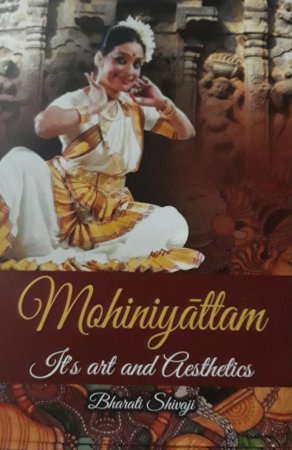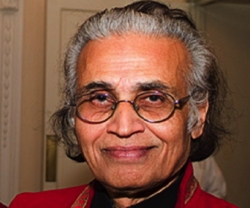
|   |

|   |
'Mohiniyattam: Its Art and Aesthetics' by Bharati Shivaji - Dr. Sunil Kothari e-mail: sunilkothari1933@gmail.com June 26, 2020  Shubhi Publications, 479, Sector 14, Gurugram 122 001, Haryana, India Revised Edition 2020 / Price not stated Foreword by Kamala Devi Chattopadhyay, Photos by Avinash Pasricha The present volume on 'Mohiniyattam: Its Art and Aesthetics' by Bharati Shivaji, a celebrated exponent of Mohini Attam, takes the reader to those early years when there were no takers for this dance form of Kerala. At the suggestion of Kamala Devi, Bharati undertook not only rigorous training in Mohini Attam (I prefer to spell it as Mohini Attam instead Mohiniyattam) but also did extensive research by visiting various parts of Kerala and contributed to the revival and further exposure to this near extinct dance form. Kamala Devi arranged for a financial grant for this project from the Sangeet Natak Akademi. Bharati already had extensive training in Bharatanatyam under Kalakshetra alumni Lalitha Shastri. She was further receiving training in Odissi also. I had seen her Bharatanatyam performances in early seventies when she performed at Kal-ke-Kalakar festival in Mumbai. With a sound background in Bharatanatyam, Bharati was well equipped to grasp the technique of Mohini Attam. She was fortunate to receive training from no less a guru than Kalyanikutty Amma, wife of the great Kathakali artiste Kalamandalam Krishnan Nair. Kalyanikutty Amma was based in Tripunitura where Bharati spent a lot of time. Another person with whom Bharati worked closely was Kavalam Narayana Panicker, renowned playwright, musicologist and an aesthete. In particular, his contribution to revival of Sopanam style of singing of Kerala is most noteworthy as its use for Mohini Attam in place of Carnatic music, lent a distinct character to the form. Bharati worked along with him when they reconstructed the form and also choreographed a few items for the repertoire. The book gives in detail, information about many regional dance forms of Kerala which have contributed to Mohini Attam. Her visits therefore to various villages opened up for her, insights into the various influences to which the Mohini Attam form was exposed to. In the process, the author traces historical, literary and sculptural sources. She found several citations on sculptures in the temples. The aesthetic part of the form is explored through Sattvika, Vachika, Angika and Aharya aspects of the form. Bharati acknowledges the support she received from Mitran Namboodri, an authority on Tantra Shastra with religious aspects of Kerala culture. Guru Paramashiva Menon of Trivandrum had extended all help in the initial stage for her researches. Bharati also mentions that she is indebted to Govindan Kutty of C.V.N Kalari for having received lessons in Kalaripyattu for the basic body discipline. She mentions Arjuna Nritya dance form, whose only living exponent was P.S.Kumaran living in Kuruchy village. From him she learnt intricate talas. The study of form like Patayani from Patayani Asan Madhavan Pillai, of Thullal form under Bhaskar Pillai of Attingal and overall acquaintance of Kathakali from Nelliode Vasudevan Namboodri and Chengarpalli Aniyan, and watching Kuttiyattam legend Mani Madhava Chakyar, staying with him at Lakidi and the rendering of soulful Ashtapadis from Gita Govinda by Janardhanan of Guruvayur temple gives the reader, the vast canvass Bharati has covered for Mohini Attam. She had also visited Ramamangalam, the holy place of Shatkala Govindan Marar, the veritable Sopanam music saint, and had gathered valuable material from local musicians like Krishnan Kutty Marar. The assistance she received further about the musical instrument Edakka from its master Pallavur Appu Marar and his brother Manian Marar helped her understand the relevance and accompaniment of the instrument in a Mohini Attam recital. She had received information about dasis of Tirumal Devaswom, Cochin, from Purushottam Mallya. She also felt the need to study the murals, sculptures, bas-reliefs of various temples of Kerala to trace the lasya element of Mohini Attam and visited them, getting them photographed by Avinash Pasricha. There is also a mention of Mohini Attam seminar held in New Dehi in September of 1984 by Kala Ambalam, when Kalyanikutty Amma came from Tripunitura and several photographs were taken of the basic stances of Mohini Attam and pada bhedas, feet positions. Reading through the book, her journey, one gets a sense of thorough study Bharati has made of the Mohini Attam dance form. Divided into five chapters dealing with Land of Parashurama and moving on to Lasya in Kerala, through the lens of sculptures, literary sources, historical references, Dasi tradition, Bharati takes a sweep of Mohin Attam through ages, and dwells on its renaissance which brings her study to present times - the contribution of Maharaja Swati Tirunal, the hospitality offered to Thanjavur group nattuvanars and artistes, and how Bharatanatyam's influence was being seen on Mohini Attam form, how the reputed dancer Sugandhavalli used to perform, when in place of Alarippu the item called Cholkettu was performed, how the Maharaja and his colleagues introduced Jatiswaram, Sabdam, Varnam, Padams and Tillana. However, most of these items were forgotten. But the Varnams and Padams composed by the Maharaja and Irayimman Thampi are still performed. An erudite musician and scholar, Parameshwar Bhagavatar was employed to prescribe the mode of expression. The great poet Vallathol Narayana Menon, who established Kerala Kalamandalam in 1930 to revive Kathakali, also sought one teacher Krishna Panicker who knew Mohini Attam. Mukundaraja and Vallathol engaged him to teach Mohini Attam. Vallathol persuaded Kalyanikutty Amma, and Guru Gopinath's wife Thangamani to learn Mohini Attam. In the thirties, as per Mukundaraja's information, Ragini Devi, mother of Indrani Rahman was visiting Kalamandalam and studying Kathakali. Shanta Rao had joined to study Kathakali under Ravunni Menon and she also studied the full course of Mohini Attam under Krishna Panicker. Another younger girl, Sarojini Naidu's sister Sunalini Devi, had also joined to study Mohini Attam. Bharati has given a list in a tabular form of several Mohini Attam students and from which village they came from. This is for the first time that such information has been made available. Chapter 4 deals with abhinaya and there are illustrations of various hand gestures, hasta mudras and also of samana mudras, similar hand gestures and Mishra - mixed mudras. The Angika abhinaya part has few photographs of body movements and feet positions. In Aharya, the bun taken on one side of the head has a similar representation in a sculpture. The coiffure of Mohini Attam is altogether unique and inimitably distinct from that of other styles. In other styles, the hair is generally plaited. In Mohini Attam, the hair is gathered into a bun on left side of the top of the head. Sattvika abhinaya has good illustrations expressing sentiments. Following overall Natyasastra principles, Mohini Attam is governed by the Rasa Theory. The repertoire chapter is most noteworthy. Bharati mentions leading exponents like Madhavi Amma, Chinnammu Amma and her disciples Kalamandalam Satyabhama, Kalamandalam Leelamma, Kshemavathy, Sugandhi, and others. Bharati observes that in Varnam, there is complete absence of Jati or Vaittari, as in Bharatanatyam. She explains how sanchari bhavas play an important role in Varnam in Mohini Attam. The second half of Varnam is danced in pure dance and abhinaya. The most important contribution of Bharati is to introduce Ashtapadis of Gita Govinda in Mohini Attam. The renderings of Ashtapadis in Guruvayur temple and the accompanying music were great inspiration to Bharati. Her understanding of body movements with the study of Kalaripayattu, the parallels of Nangiarkoothu and Mohini Attam, choreographing new items like Jiva with help of Kavalam and the tala structure are salient features of Bharati's Mohini Attam. But what she has done which is remarkable is to extend the thematic content like the story of Chandrotsavam in a dance-drama form, the singing of Ramacharita Manas in Awadhi for using chaupais of Tulasidas in Mohini Attam, Gurudev Rabindranath Tagore's Bhanusingher Padavali using Bengali Rabindrik music and finally even using Tchaikovsky's Western classical music for Swan Lake, choreographing with her daughter Vijaylakshmi and inviting Santosh Nair to play the male lead role and her disciples as swans in Mohini Attam, which received great appreciation when performed in Russia. The illustrations of the choreographic works of Bharati under the banner of her institution Centre for Mohini Attam, draw attention to her pan-Indian approach. She also speaks of the future of Mohini Attam which according to her will not only be bright but also innovative. Exploring new dimensions with diligent research, Mohini Attam's horizon shall expand. A welcome addition to the limited literature on Mohini Attam, Bharati's book will provide inspiration to the young generation. As a performer, she has embellished the book with the dynamics of Mohini Attam form illuminating its aesthetics.  Dr. Sunil Kothari is a dance historian, scholar, author and critic, Padma Shri awardee and fellow, Sangeet Natak Akademi. Dance Critics' Association, New York, has honoured him with Lifetime Achievement award. Comments * Nice review. There are some discussions on the devadasi name 'Sugandhavalli.' In Swati Tirunal movie, the director used the name 'Sugandhavalli' but in history it is not the same. Thank you so much for introducing the book. - Dr K Sampreetha (June 27, 2020) Post your comment Unless you wish to remain anonymous, please provide your name and email id when you use the Anonymous profile in the blog to post a comment. All appropriate comments posted in the blog will also be featured in the site. |